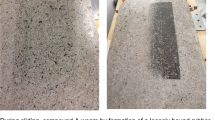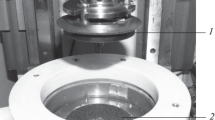Abstract
Rates of wear have been determined for steel and bronze scrapers sliding over rubber surfaces. The wear rates were found to depend strongly upon the particular elastomer used, varying by orders of magnitude even though the other ingredients in the compound and the physical properties of the rubber were largely unchanged. In the absence of oxygen the metal scrapers were found to wear away much faster in general; by a factor of 5 to 50 times, depending upon the elastomer. Butyl rubber was anomalous in this respect, however, causing three times greater wear in air than in nitrogen. These diverse observations are attributed to the direct attack upon metals of free radical species generated by mechanical rupture of elastomer molecules during abrasion. The rate of metal wear is closely correlated with the stability of polymeric radicals formed in this way. When the radical is highly reactive it is thought to take part primarily in internal reactions and thus cause little wear of the scraper. On the other hand, relatively stable polymer radicals appear to attack metals vigorously.
Similar content being viewed by others
References
A. N. Gent and C. T. R. Pulford, Wear 49 (1978) 135.
G. V. Vinogradov, V. A. Mustafaev and Yu-Ya. Podolsky, ibid 8 (1965) 358.
G. A. Gorokhovskii, P. A. Chernenko and V. A. Smirnov. Sov. Mat. Sci. 8 (1972) 557.
YU. A. Evdokimov, S. S. Sanches and N. A. Sukhorukov, Polymer Mech. 9 (1973) 460.
G. A. Gorokhovskii, T. V. Dmitrieva and V. O. Movchan, Sov. Mat. Sci. 10 (1974) 47.
G. A. Gorokhovskii, I. I. Agulov, T. V. Dmitrieva and M. I. Dudnik, ibid 11 (1975) 320.
A. G. Thomas, J. Polymer Sci. Symp. 48 (1974) 145.
D. H. Champ, E. Southern and A. G. Thomas, in “Advances in Polymer Friction and Wear” (Proceedings of ACS International Symposium, Los Angeles, 1974), Polymer Science and Technology, Vol. 5A, edited by L. -H. Lee (Plenum Press, New York, 1974) pp. 133–144.
G. M. Bristow and W. F. Watson, in “The Chemistry and Physics of Rubberlike Substances”, edited by L. Bateman, (Wiley, New York, 1963) Ch. 14.
M. Morton, I. Piirma, R. J. Stein and J. F. Meier, Proceedings of the International Rubber Conference, London (1962) pp. 49–59.
R. W. Lenz, in “Organic Chemistry of Synthetic High Polymers” (Interscience, New York, 1967) Ch. 18.
F. P. Baldwin and G. Ver Strate, Rubber Chem. Techol. 45 (1972) 709.
D. Barnard, L. Bateman, J. I. Cunneen and J. F. Smith, in “The Chemistry and Physics of Rubberlike Substances”, edited by L. Bateman (Wiley, New York, 1963), Ch. 17.
Author information
Authors and Affiliations
Rights and permissions
About this article
Cite this article
Gent, A.N., Pulford, C.T.R. Wear of metal by rubber. J Mater Sci 14, 1301–1307 (1979). https://doi.org/10.1007/BF00549301
Received:
Accepted:
Issue Date:
DOI: https://doi.org/10.1007/BF00549301




